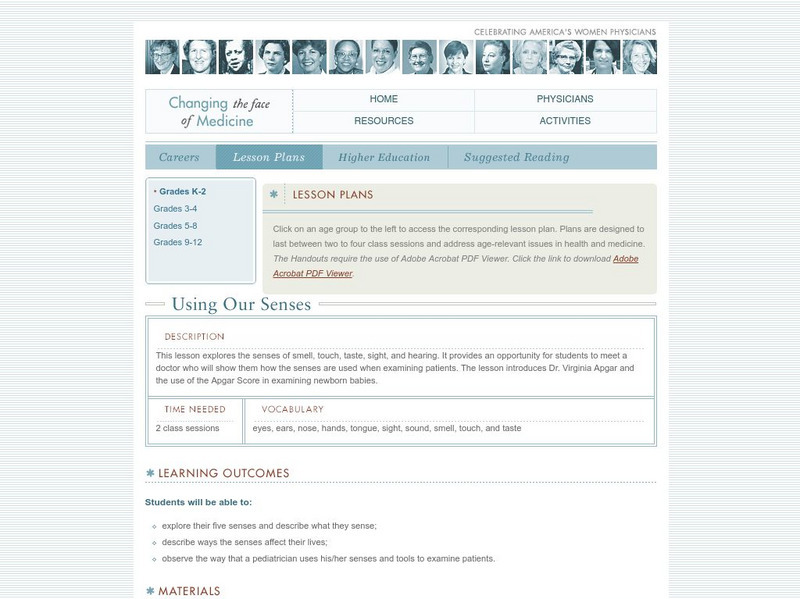Hi, what do you want to do?
Curated OER
Human Parts
Very young learners who are studying the human body will use this worksheet to identify certain body parts. A cartoon drawing of a boy is shown, and learners must draw lines matching up words such as arm, tummy, foot, and toes to the...
Curated OER
Tasters' Choice
Students taste foods, some of which are familiar foods and some of which are uncommon foods. They compare and contrast the tastes and graph their likes and dislikes.
Curated OER
The Magic School Bus Goes Upstream
Students participate in an experiment that shows them how to use their senses to find their way "home." This experiment is based on the video that shows how salmon find their way to their home stream.
Curated OER
Funny Ears
Young scientists get a worksheet that has a picture of a dog, a donkey, a person, a mouse, a rabbit, and a cat. Each picture has the wrong ears attached to it! Learners must draw lines matching up the ears with the correct recipient. The...
Curated OER
Talking Duck
Students visit a local wetland or WWT centre and record their observations by writing or drawing on the downloadable pupil activity sheet.
Curated OER
Homes for Hermit Crabs
Students discover the differences between hermit crabs and mollusks and identify their parts. After reading a story about hermit crabs, they complete an anatomy worksheet. For another activity, students fold and cut a diagram of a hermit...
Curated OER
An American Scene Painter
Students study the work of American scene painter Charles Burchfield. In this visual arts lesson plan, students research the nature paintings of Burchfield and then paint their own watercolor scenes in his style.
Curated OER
Pumpkin Investigation
Students examine pumpkins and make a book depicting and describing the inside and outside of a pumpkin.
Curated OER
Those Busy, Buzz'n Worker Bees
Students research information on worker bees. In this insect lesson plan, students review the body parts of insects and how bees find flowers. They discuss compound and simple eyes and the life cycle of a worker bee.
Curated OER
Taste Buds
Students sample several sweet, sour, bitter and salty foods. They determine what part of their tongue tasted each flavor.
Curated OER
Blind Man's Bluff
Students count to five. They use two blindfolds and a bean bag. One child is blindfolded. The other children sit close together in a circle on the floor.
Spin the blindfolded person around three times, then release. The children clap...
Curated OER
Can I Tell You Where I am?
Students participate in a lesson that is concerned with the factors of describing a neighborhood. They follow a set of target questions in order to obtain information about individual neighborhoods. The information is used The write...
Curated OER
Outdoor Observation
Students examine their outside environment. They use their senses to make observations of the four seasons. They keep a chart of all of the data they have collected.
National Institutes of Health
National Library of Medicine: Using Our Senses
This lesson plan site delves into the senses of smell, touch, taste, sight, and hearing. Students will be able to describe the ways senses affect their lives and how a pediatrician uses his/her senses to examine patients.
The Franklin Institute
The Franklin Institute Online: Coming to Our Senses
Help students make "Sense," of their senses by using them in the classroom. Site provides discovery activities students can do on themselves, in their classrooms and around campus. A scavenger hunt is also provided.
BioEd Online
Bio Ed Online: The Senses
In the following activities students can learn about the basic characteristics and structures of the brain, skull and sensory system; investigate sight, hearing, smell, taste and touch; and discover how the brain and the senses are...
Alabama Learning Exchange
Alex: Have You Seen My Mother?
This instructional activity will introduce the sense of smell. It will show how an animal, such as a bat, finds its baby by using the sense of smell. Students will have the opportunity to view information on the Internet to learn more...
Science Education Resource Center at Carleton College
Serc: Backyard Science the Five Senses
Kindergarten students will use their existing outdoor expertise to help them focus on the scientific study of their five senses in stations.
ABCya
Ab Cya: Five Senses
The Five Senses is an educational activity for kids to learn about taste, smell, vision, hearing, and touch. The lesson will introduce each of the five senses one at a time. Students will then be assessed through a multiple choice...






















